Photo: Earl Gardner
It took all of 90 minutes in 2017 for Philadelphia Union to match their road points total against Western Conference teams from a year ago.
Last season, the Union drew a memorably ugly match against Colorado Rapids to claim the only point they would earn during their travels to the west, going 0-4-1 overall.
More impressive was how they snagged the point, with strong play from two holding midfielders making MLS debuts and grinding two-way play from Chris Pontius and especially Fabian Herbers. Philly did not create many chances, but they conceded fewer.
Consider this: Jordan Harvey’s shot off a corner — the one Keegan Rosenberry saved off the line — was the only Vancouver shot on frame. On the other end, the Union’s best look was a spinning backheeled effort from Bedoya.
Midfield… battle?
Throughout preseason, Jim Curtin rotated between an aggressive midfield that slotted Alejandro Bedoya next to Haris Medunjanin and a more conservative setup with a holding player sitting in beside the Bosnian. Starting the season on the road, Curtin played it tactically conservative, but that meant being risky in his lineup choices.
Make no mistake: the Union head man rolled the dice by starting Derrick Jones, and he was rewarded.

Medunjanin (top left) and Jones occupy strong positions to stamp out quick counterattacks through the middle, but this leaves them far behind the rest of the Union attack.
Jones, in his first MLS minutes, was far from flawless. He suffered a loss of confidence and dip in form after an early misplayed pass, but recovered to provide one of the better performances the Union have seen from the defensive midfield role in quite some time. Jones’ athleticism was immediately noticeable, but it was his positioning that made him the standout performer on the evening.
“I thought he was the standout performer on the night — both teams,” Curtin said of Jones.
And while that is debatable, there is no question that Jones put in an exceptionally mature and disciplined showing.
The keys for Jones and Medunjanin were controlling the center and supporting the center backs. For Medunjanin, this meant finding enough space to turn with the ball and covering runs when his rookie sidekick stepped to the ball. Jones often had the more complex task of providing the short outlet through the middle without advancing too far beyond his partner. Against Vancouver’s soft pressure, both players were comfortable collecting the ball and turning, though Jones was one of many Union players that preferred to return the ball whence it came rather than quickly turning to switch fields. Yet it was only when Philly quickly moved the ball across the pitch that they were able to penetrate past the home side’s own disciplined, deep-lying midfield.
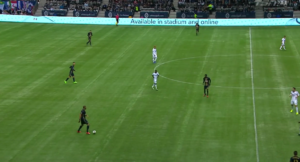
Jones occupies a good position between defenders, but doesn’t recognize that taking a few steps backward means he could turn with a pass and advance into space.
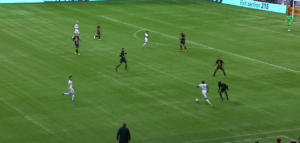
Philly’s holding mids played very conservatively. Here you can see Medunjanin (furthest left, near top) has dropped deep in support, allowing Vancouver space in the center but preventing them from advancing through that route.
Jones: So good, and so much room to improve
Jones should improve as he becomes more comfortable in MLS and begins to think more independently, so criticizing a 20-year-old rookie for being a few steps out of position seems harsh. Let’s not call this criticism, then, just pointing out areas in which the young giant can grow.
Jones’ conservative passing game meant the Union often required Medunjanin to get on the ball to switch fields. In the screenshot to the right, you can see that Jones has found a good position between defenders but has acres of space behind him. By taking just a few steps back, Jones can turn with the ball and attack space, disrupting the defense’s shape and pushing the ball to the far side for an attack.
One issue the Union had turning buildup into chances was Bedoya’s relative absence in the middle during the first half. In the screenshot just below, you can see that when Bedoya drops slightly off the back line, he has space to act as a link to the far wing, and those quick horizontal transitions are how Philly builds many of their most dangerous moves. Now if Jones takes two steps forward, he is in position to attack the middle of the pitch with the ball, drawing the defense and finding Bedoya in the left half-space.
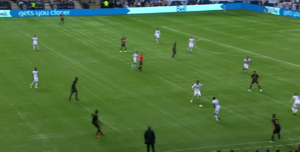
Jones again needs to move only a few steps to find enough space to receive the ball and turn, and this time he does have Bedoya available to attack the far side.
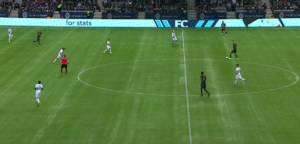
The Whitecaps preferred a compact shape to any sort of high pressure most of the time, so even with all that space Medunjanin has few incisive options.
Defensively, both midfields worked in relative sync, with Medunjanin showing impressive instincts tracking back to a holding role when Jones stepped to press. Laba was perhaps the least consistent man in the middle as his form dipped following a strong opening half hour. But overall, the prevention focus of both duos was executed so effectively that the match never got out of second gear.
This tactical wariness made for a match that seemed as if it could only be decided by an individual error. Both teams were hesitant to commit more than four to an attack, which meant defenders accumulated around the ball carrier like zombies in The Walking Dead. Laba’s early effort over the bar may have been the most aggressive any midfielder got until Jones found his way to the edge of the box and overhit a through ball midway through the second half.
Play was pushed wide by both teams, and dangerous crosses were at a premium. The Union’s strength in back masked issues in their zone coverage farther up the pitch. More than once, Jay Simpson, Alejandro Bedoya, and Chris Pontius struggled to effectively communicate and hand off runners as Vancouver worked the ball out of the back. Allowing Laba or Kekuta Manneh to receive the ball behind the first line of defense forced the Union to collapse centrally, and this exposed the right side of the defense, where Rosenberry had acres of space to cover as Oguchi Onyewu played a very narrow position. Time and again, Vancouver’s touch and vision let them down when they seemed likely to create a good opportunity.
Stuck on the same side
The first half opened with both sides testing the debutantes in the center of defense. Vancouver smartly looked to move Onyewu by playing behind Rosenberry, and the Union sought to test Christian Dean by running Jay Simpson behind Jordan Harvey.
Onyewu remained narrow throughout the contest, and the Whitecaps had early success running at Rosenberry with superteen Alphonso Davies. Philly adjusted by drawing Herbers back to help on Davies whenever possible, a move which could be seen as an indictment of Rosenberry but is more about the outsized skills of the Vancouver winger than defensive problems at right back. Make no mistake: Rosenberry had an alarmingly inconsistent match on the ball, with Davies closing him down quickly and forcing a number of bad choices. But from a defensive standpoint, the Union were always going to have to offer help by sliding Onyewu over or pulling Herbers deep, and they chose the latter.
Dean, however, needed no help. The former No. 3 overall SuperDraft pick — chosen after Andre Blake and Steve Birnbaum — showed an impressive blend of size, closing speed, and anticipation to smother Simpson. As a result, Simpson only had five touches beyond the center circle in the first half, all but one of them a backward pass. That’s fine hold-up play, but it did little to stretch Vancouver or provide the advanced touches needed to find Bedoya’s aggressive forward runs.
Bedoya stays high early
In order to create dangerous moves without moving holding midfielders into advanced spaces, both teams needed to draw their opponents into the center with their initial passing then spread the ball wide. Unfortunately, neither side found consistent access to their central attackers, and neither advanced midfielder reliably found the spaces (Bedoya) or vision (Manneh) to disrupt the defense and create scoring opportunities.
Let’s start with Bedoya.
After the match, Kevin Kinkead described the Union’s attacking midfielder as a “volume” playmaker. That can be a euphemism or a compliment depending on context, tactics, and expectations. For instance, some players need a lot of opportunities to create a few good chances. A system can build around this by using that playmaker in a hard-working, all-over-the-pitch role that sees them on the ball quite often. On the other hand, if you put a volume playmaker in a role where they have to make the most out of their few opportunities and do it in tight spaces, you’re probably in trouble and need to find out what Chaco Maidana is up to these days.
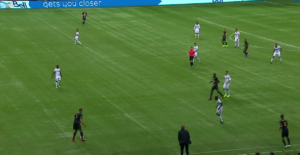
With Bedoya on the back line, Philly has no link to move the ball across the pitch to Fabinho, who is moving into a dangerous attacking position.
Early on, Philly appeared to be using Bedoya in a role that garnered him few touches, but the ones he got were in deep positions. The US international often looked to make runs into the spaces that opened with Simpson dragged a center back out to the wing, but Simpson’s inability to win those battles meant Philly was left with Bedoya up the pitch and out of position when the ball was turned over. Opta credited the Union man with zero defensive actions in the first half (including recoveries!) despite his high work rate. This reflects Bedoya’s vertical movement and Philly’s aim of exploiting space between a young, inexperienced central defensive pairing.
On the right, you can see how Bedoya’s advanced positioning leaves the Union with only a defensive cycle or a stunning crossfield ball from Onyewu as means to switch fields. Particularly with Medunjanin favoring deeper positions, Bedoya needs to playing a linking role rather than looking to get on the end of balls through the back line.
The strategy itself is not necessarily a bad one, but it seemed a poor fit given the personnel on the pitch. Simpson couldn’t win aerial battles or collect balls cleanly enough to find a runner who could drive at the defense and find Bedoya’s runs. When Fabian Herbers did find Bedoya behind the defense, it was after he beat a man by himself and threatened the back line on the dribble.
As the match wore on, Bedoya began to play a deeper role that allowed him to connect with the other midfielders. This gave the Union far better control of the center of the pitch defensively, and — just as importantly — opened spaces for Fabian Herbers to advance on the right. In the first half, Herbers and Bedoya were both aiming to occupy the half-space just outside the Whitecaps’ box on the right. With Medunjanin and Jones hesitant to step forward, this left a gaping hole in the center, and meant Philly couldn’t run at the suspect individual defense of Andrew Jacobson and Matias Laba.
Bedoya’s deeper role, however, did not produce the sort of central connections Jim Curtin may have hoped for. Medunjanin drifted to the right to combine with Rosenberry, who now had more space to advance behind Herbers. Yet the Union struggled to quickly switch play from right to left, and Fabinho never managed to rampage forward into space because the ball only made its way across the field by cycling through the back four.
Going forward, the Union need to figure out how they want to use Bedoya in the build-up phase of the match, because for all his talents, he should not be occupying a role that resembles the one that, say, Roland Alberg might play.
With Bedoya advanced, Philly has the pieces to play a more movement-oriented attack that can exploit the man-oriented zone defense many MLS teams use through the center.
A man-oriented zone means players will pick up opposing runners in man coverage when they enter their zone, but they will drop back into shape once that runner leaves. This scheme can be exploited by moving players from the wings or from the front line into a zone once a defender is already occupied in man coverage. That sounds complicated, but it just means that when a central player manages to pull, say, Laba or Jacobson forward, a winger or striker needs to recognize that a zone is now uncovered and move into that space quickly. Philly actually did a good job drawing Vancouver’s midfield out of shape but did a poor job moving players into unoccupied zones.
Defensive heads up
Keegan Rosenberry struggled in a number of one-on-one showdowns with uber-prospect Alphonso Davies, and that’s fine. Unless you are writing Paolo Maldini on your team sheet each week, expecting a fullback to contain a dribbler as talented as Davies is, let’s say, not smart. Dropping Herbers to help was a reasonable solution and it generally worked out well.
The bigger issue for Philly was their rotations on the right side when the Whitecaps did manage to collect the ball in the center. Kekuta Manneh has a long list of qualities, but vision in tight areas is not near the top of his list. And that is why it both makes more sense to play him as a winger and why the Union weren’t punished when they backed off and let Manneh collect and turn in the middle.
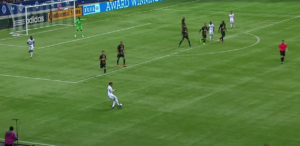
More than once, Fabinho found himself behind the rest of the defense and slow to return to the line.
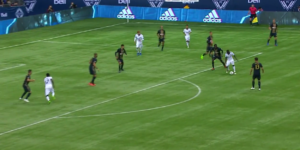
Fabinho is casual returning to the defensive line, but Jones covered the passing lane into the channel.
More than once, Manneh or Davies mishit balls, missed runners, or misread the defense when a skilled playmaker would likely have punished Philly. Specifically, this occurred on the right, where Onyewu was reluctant to leave the middle and left oodles of space for Rosenberry to cover. The same problem popped up in the final preseason match, with DC United pulling Marquez wide, cutting play back central and finding Lloyd Sam when Onyewu drifted to the left half of the pitch and Rosenberry was left at sea with an entire half of the pitch to cover alone. This is an area the Union need to shore up quickly, because Greg Vanney will be pointing it out to Jozy Altidore, and the big man won’t miss Giovinco’s runs when he holds the ball in front of Philly’s back four.
The other thing to look for going forward is Fabinho’s recoveries. The fullback — and he’s not the only one — has a history of returning slowly to reform the offsides line after getting drawn deep. That occurred more than once on Sunday and will be duly exploited by teams like the Red Bulls and Toronto FC.
Looking ahead
The Union cannot be unhappy with a road point to start the season, nor can they be thrilled that their offseason machinations produced a single, bouncing, low percentage shot from the number nine position. But overall, Jim Curtin has to be happy with his team’s execution, particularly on the defensive side of things.
Jones and Medunjanin were very disciplined at remaining central and that eliminated many of the simple transition outlets and runs through the middle that put the defense on its heels last season. Teams will look at Vancouver’s ability to get the ball into the box and wonder if they can send a late runner through when Philly’s mids collapse deep to help, and they will certainly continue to probe behind Rosenberry if Onyewu is going to continue his narrow positioning.
How Philly tweaks their system to account for these attacks will say a lot about their ability to earn points on the road this year. Keeping Bedoya in a more positionally disciplined role gave the team far more control over the center in the second half, but Medunjanin struggled to figure out where to go with the ball once the Union captain stayed close. Creating cues and patterns that quickly move the wingers into unoccupied central zones may open the width for advancing fullbacks, but it has to be done far quicker and more efficiently than it was on Sunday.
Additionally, this match showed off a Union side that seemed comfortable sitting in and breaking forward. Playing at home — as the Whitecaps showed — they may not generate much offense without committing another player forward in attack. Can they shift Jones or Medunjanin closer to the box without giving up transition chances?
These are the questions facing Curtin and the Union after 90 minutes in 2017. They are, undoubtedly, far better questions than those asked after 90 minutes last year.
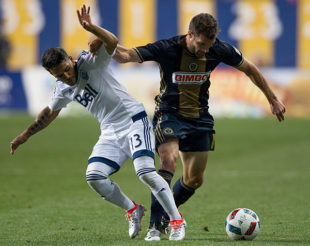

I’ve been waiting months for the first one of these! Thanks a bunch Adam
+1
Thank you for reading! Definitely going to be fun… or maybe just interesting… to see what Philly rolls out this season tactically, since it seems like they’re going to do more shifting between strategies based on the opponent/location of the match.
Always good reading these! Ideally, it will be even better to learn new/different things as line-ups (hopefully) change as you referenced!
What part of az are you from?
From Glendale, Live in Surprise, Teach in Avondale AzJeff! You?
Tucson, but I drive all over the state.
My brother lives in tempe and teaches at asu.
I can’t seem to reply further inline.
no worries! Good to know i have a fellow Arizonan out here!
If we want to start pointing out the offensive disconnect between midfield and attack, where doe the disappearing acts of Pontius and Herbers come in.
Herbers I don’t think has the touch or quick decision making or passing ability to ever contribute to a prolonger attack.
Pontius, for all his talent and praise, still is known to disappear for long period of time and that hurts our link to midfield and attack too.
It would be nice to criticize everyone for a bad offense and not let two players off the hook right away.
… for whatever reason ‘we’ more often than not (from years reading) notice the defensive work rate of the outside mids over the ability to impact a game offensively. Yes I know Chris Pontius scored goals last year.
.
As argued yesterday…its a blindspot IMO.
Heed the trumpet of the mighty elephant!
.
OMG, el P! you speak truth, and how.
.
For those in doubt, see above references in the post to Herbers dropping back when possible to help Rosenberry with Davies.
In fairness to Adam, Herbers’ and Pontius’ weak showings were reflected in the player ratings by Dan. Also, they are as close to “known quantities” in this the first match, as the Union get. Whereas the center of the pitch has been overhauled and reshuffled and offers the greatest interest in how it’s working or not. Plus how long do you want this article to be? Pretty sure Adam doesn’t have all the free time in the world.
The 3,000 words he rolled out for this one is about as thorough as you could possibly expect for a typical MLS match. 😉
I thought the same thing upon reading it… Goddamn this guy brings it.
I agree, but they came out with a conservative gameplan since they were playing with a bunch of new players on the road against a team that can kill you on the counter attack. That seems perfectly fine for the first game to me. I hope that everyone gets more comfortable and adjusts and we can start dictating the games, especially at home.
@James – My memory is that Herbers was one of the more divisive players last season, with some critical of his touch and others excited by his movement. I think he could still end up anywhere from a regular MLS starter who contributes 6-8 goals and a hatful of assists each year to a perennial benchie that grades out as an ‘energy’ player.
–
A lot of that will come down to decision-making, I think. There was a moment on Sunday when he was played through on the right by Simpson and he kept his head down and powered in a low cross even though he probably had the time to collect the ball and pick out a late runner. I think those moments are going to be what determines his trajectory.
–
Regarding Sunday, I didn’t dwell on the wingers’ lack of offense so much because a) Nobody did much, and the little bits of offense the Union did have came through those wing players (Pontius driving into the box and forcing Sheanon Williams into a sensational sliding tackle, Pontius finding room to shoot at the top of the box, Herbers sending Bedoya through on the right). It may have even been Pontius who put in the ball Bedoya backheeled, but I don’t remember right now.
–
Additionally, both guys (Herbers in particular though) put in a lot of defensive work dropping deep into their own half. Once it became clear Vancouver was looking at the space behind Rosenberry, there were multiple times that Herbers tracked all the way back to provide support below the box.
–
Last, the biggest thing I like about Herbers, and maybe I should write about this so I can get more feedback, is that he tends to stick to what he’s good at, which is making vertical or diagonal runs and attacking the back four when he has the ball. Without Barnetta, the Union are going to be fairly reliant on their wing players to attack with the ball at their feet, and even if that means losing possession a few times, I think you want your players trying to do what they do well.
Actually, I have to give credit to Herbers for one other thing. He didn’t laugh at my flip phone when I asked him to use it to take a picture of Gooch and me after the open practice in January. So he is adaptable 🙂
I love this story.
It almost sounds like you’re describing LeToux…With better ball handling skills. (And maybe better instincts too.)
It may also be worth a mention, at least, that Herbers wasn’t the first-choice starter on the right. He got the nod because Ilsinho pulled a hammy in training.
Good point.
I’d really like to see Ilsinho and Bedoya on the field together. What positions, I’m not sure. My initial thought is that they would rotate playing RW and CAM depending on whether Ilsinho pushes in. I want to have Bedoya’s work rate and defensive hustle in the center, but I also want to have Ilsinho’s chaos causing dribbles across the top of the box. Even when Ilsinho fails in a dribble, just having him out there pulls defenders out of position then when it is just Herbers out there. Bedoya, Pontius, and Herbers are all “direct” players imo, whereas Ilsinho can create space for himself or others through his movement and dribbles.
Yeah, it’s a bummer he got hurt before the game, although Davies would probably have killed us with Ilsinho in front of Rosenberry.
would have been interesting to find out whether the Brazilian has improved that aspect of his game.
I’m pretty sure that was the gameplan for Saturday, right until Ilsinho blew out his hammy in pre-game. And based on what we’ve heard so far, yes, the idea is that he and Bedoya will interchange between center and right, based on their movements.
.
My guess is that we’ll have to wait another week to see it. The injury isn’t usually a 3-day thing, so expect Herbers again on Saturday.
I actually think that was the plan for the game before Ilsinho got hurt. I do see your point though. Herbers and Pontius both have excellent workrates, one is a more refined finisher at the moment, and are mostly predictable, known quantities. Ilsinho continues to be a wildcard. As for Bedoya, I think we’ll see him develop in his number 10 role as the season goes. He’s suffering the same way Edu did when he got here by not having 1 set position.
Waiting for someone to find their footing in a position they have no success in playing is infuriating. I want a bonafide 10, not Ale struggling with positioning and distribution.
Thanks for the analysis, as always. My curiosity is peaked a bit by something I’ve been wondering since the last pre-season match against DC and noticed Herbers who was starting in the #10 slot often ina more advanced position than Simpson … If you don’t have a play-maker in the #10 role in a 4-2-3-1 lineup — and then you go out ans have a first half in which your CAM has no defensive touches — are you not really just rolling out a 4-4-2 with a midfielder in the second striker role? Or perhaps at least a 4-4-1-1 the way Red Bulls used to lineup with Henry? I know formations are fluid, but from a tactical standpoint, it feels like Bedoya is a square peg in a round hole…. Does that make any sense? And if so, as you point out, the question is (for Curtin, not you): Why not Alberg?
“No defense” Alberg?
.
Or is there another one?
That’s the point, OSC. If you’re not getting defense from Bedoya there, why not go for a better attack?
@Pete – I think you could make the argument that Philly was in a 4-4-2 shape for a lot of at least the first half. Defensively, this was partially due to the fact that without Vancouver committing a second midfielder forward, there wasn’t actually a lot of impetus to drop Bedoya in unless you wanted him to be deeper during transitions or build-up play.
–
My guess is that at some point in the second half the coaching staff decided, yeah, they wanted him deeper, but before that they preferred having him high up the pitch to work with Simpson and start a high press when the ball went to wherever the triggers were. Vancouver played it pretty safe with their passing out of the back, and despite a few breakdowns, Jones/Medunjanin were excellent picking up runs through their zones and stepping up to make sure line-breaking passes had to go back where they came from.
–
So my guess is that if Philly had been able to win a few battles on their longer balls into corners, Bedoya playing so high starts to make sense. But as it was, he ended up looking like he was on the wrong page offensively a lot of the time early on.
–
All that said, I can’t entirely disagree with your peg/hole point. A playnaker in the 10 role brings a gravity that can distort defensive shape, and Bedoya often looks like a player who reads those distortions and exploits them rather than one that causes them, so it’ll be interesting to see if he grows into the role going forward or if the Union can learn to move more effectively and let Haris playmake from deep.
Thanks for the super thorough reply. I hadn’t thought about how Vancouver’s play influenced Bedoya’s position on the field. And of course, he came closer than any other Union player to scoring. Had the Union come out with a 1-0 road victory, I’m not wondering about pegs.
I think you’re right to ask the peg/hole question though. Until Bedoya is producing like a million dollar player, the question of where he fits best is going to keep getting asked, and it’ll keep being a fair question.
If you are going to end up in a 4-4-1-1 anyway, does it make any sense to push Alberg all the way up top and have Simpson do the running beneath him? Bedoya could go to RW while Ilsinho is injured.
This might actually be worth a try when we hit the inevitable dry spell this year.
Piqued*
.
I definitely hear your comment, just look at the sixth screenshot of the game with Ale standing shoulder to shoulder with Simpson. For large parts of the game we were a 4-4-2 (with the central 2 staggered, jibing to ball side).
.
Jim should just commit to it. Why not replace swap Bedoya with Alberg and put Bedoya out wide over Herbers? At least that way no one will be kidding themselves, pretending we have a CAM.
These writeups are always fascinating to read. MANY thanks Adam!
@Dave – Thanks so much for reading!
Great stuff Adam… after reading I always see the game from a different perspective and it helps me watch going forward.
.
I am excited to watch Jones and Haris develop a relationship. I think adding Ilsinho to the mix when healthy will provide more going forward.
.
I am still nervous Alberg never sees the field, barring necessity out of injury, and I think that’s a problem. Time will tell though.
I’d love to hear Earnie’s opinion of Alberg’s highest and best use. We already know Coach curtain’s opinion!
I’m curious to see how opposing teams will choose to react to this game tape. I think the Union need to show a lot more going forward – quicker passing, more creative passing, and better runs – or else teams simply will not respect them. At the back, I expect teams to start trying to exploit Medunjanin – Nogueira he is not.
.
“On the other hand, if you put a volume playmaker in a role where they have to make the most out of their few opportunities and do it in tight spaces, you’re probably in trouble and need to find out what Chaco Maidana is up to these days.” I know Maidana is a…divisive figure, but for all his flaws, Maidana was superb at finding open spaces, getting the ball from the backs/deep mids and hitting dangerous balls forward. I get the emphasis on having 2-way players all over the pitch, but we may see a lot more 0s from the Union if they play like they did on Sunday. Bedoya is supposed to be Maidana, but with defensive ability, I think. But whether it’s him or Curtin, his positioning is…erratic, and not in a good way.
.
For those wondering (like I was), Maidana is currently playing in Qatar.
Always enjoy reading these! Thanks Adam!
.
I for one am interested to see Fafa on the wing for a longer amount of time. Dare I say it, starting over Herbers or Pontius.
.
Here it my take: Especially with Ilsinho out for at least 1 more game (assuming based on age and injury) and we live in a world where everyone hates Alberg (at least enough to not play him), there seem to be very limited options going forward. Having the pace of Fafa could change how other teams have to defend. Pace, even more than creativity, can change the way formations and discipline are taught in preparation for the weekend. I feel like our line-up doesn’t require opposing managers to worry too much. Not a lot of pace, not a lot of creativity, no playmaking no.10; we have that wheel play on set-pieces 30ish yards from goal though…but we haven’t finalized that masterpiece yet. Plus it would allow Herbers/Pontius to come in at 65mins and really press tired legs with a more physical aspect.
In a perfect world with a creative manager we’d see a lot of turnover on the wings and we wouldn’t see consistent starts without results. In a perfect world Jim would give all of our wingers a chance until something clicked.
.
But we don’t have that mgr. So expect nothing but stagnation.
+1
Wished I got to see the game but the analyses are key to keeping up with the season when you can’t. Hopefully the Union will be able to exploit teams who press higher. We will be able to see whether Derrick Jones’ ability to transition is a liability or a strength in being able to find medunjanin, or link play himself. though, if there are 2 center backs who can park the bus for 90 and still come out looking fresh its Gooch and Marquez.